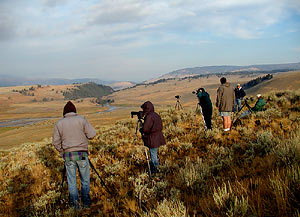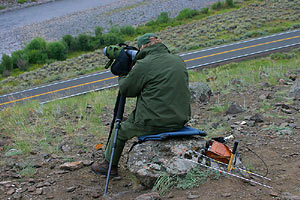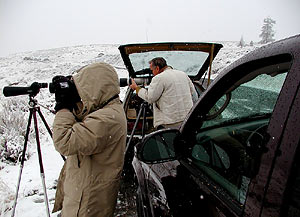Wolf watching is an activity almost exclusively confined to Yellowstone National Park,
at least for the general public. Just the fact that you might see a wolf is wonderful, but the fact that you
probably WILL see one if you go at the right time of year and spend time in the right locations is
 just incredible.
In a 7 day visit we typically see the large canids 3-4 days in both the spring and fall. Sightings every day are not
uncommon. Sometimes one lone
wolf and sometimes a pack of 18. Luck has a lot to do with it, but there are several things you can do to remarkably
improve your chances.
just incredible.
In a 7 day visit we typically see the large canids 3-4 days in both the spring and fall. Sightings every day are not
uncommon. Sometimes one lone
wolf and sometimes a pack of 18. Luck has a lot to do with it, but there are several things you can do to remarkably
improve your chances.
Where
The Best Place - The Lamar Valley - a magical name for the wolf groupie fraternity. If you want to see Canis Lupus the
Lamar is the place to be. The Druid Peak pack lives there most of the year and surrounding packs make their appearance
on a regular basis. The prey base is huge, the Lamar River insulates the wolves from most human contact, and the large
open valley is a great place to spot in. If you go to see the wolves, try to stay as close to the Lamar Valley as you can.
Roosevelt lodge is a good option if you want to stay in the park, but its season is short. Silvergate and Cooke City both
have lodging available and camping is nearby at Pebble Creek and Slough Creek campgrounds. Close is good because you want
to be at the Lamar Valley at dawn and dusk. We've seen wolves at 2:00 in the afternoon, but our best sightings have occurred
from 6:00am to 10:00am.
In the Lamar good viewing begins from about a mile east of Soda Butte cone all the way to the last turnout (Fishermans)
before the Lamar canyon. The Slough Creek area is also good from the Slough Creek campground road entrance through
Little America to the Yellowstone Picnic area. The wolves can be anywhere in those areas.
When
The best time of year to view wolves is winter. They are more visible during the day, the prey is in plain sight,
 and the wolves (especially the black ones) stand out in the snow. The only difficulty is that it gets cold in Yellowstone,
VERY cold. I have never gone in the dead of winter - and I'm sure I will - but those -42 degree days keep me away. The
10 degree days keep me away. I want to see the wolves but I prefer warmer conditions. Someday......
and the wolves (especially the black ones) stand out in the snow. The only difficulty is that it gets cold in Yellowstone,
VERY cold. I have never gone in the dead of winter - and I'm sure I will - but those -42 degree days keep me away. The
10 degree days keep me away. I want to see the wolves but I prefer warmer conditions. Someday......
The winter viewing is
said to be incredible (my girlfriend, Christine, has gone in February and had a great time). I've gone as early as May
and as late as October and it was cold, but still comfortable enough to stay out and watch the wolves for a long time.
You can also watch from the car if you wish. Optimum viewing for Yellowstone wolves is from about the middle of September
to the middle to end of June. July and August are pretty hot and the elk and wolves travel to higher elevations.
What to do when you get there.
When you reach the Lamar look for people with spotting scopes and radios. They will probably be wolf spotters for the
Park Service. Ask them if they see anything presently, what recent activity they have observed or heard of in the park,
if there are any carcasses, the location of the packs, and where they think are the best places for seeing wolves. These
people are generally very nice and very willing to help. The pullouts in the Lamar have common names which they will
probably refer to in their directions. Here is a map done by John DeMartino (AKA-JohnD) and David Hinton (AKA-DFF) who post on the
"The Total Yellowstone Chat Page"
which labels all the major stops in the Valley so
you know where to go.
Map
Original Map (Large)
Looking for wolves
If nothing is visible, you can cruise the common areas like everyone else. I would glass these places regularly:
1. The Druid Pack rendezvous site
2. Jasper Bench (straight across from Dorothy's knoll).
3. The Slough Creek hills and across the road from Slough in Little America.
 4. In denning season you should spend time at the Hitching post or Hiking bridge pull offs at dusk and dawn
to see the wolves leave and return to the den.
4. In denning season you should spend time at the Hitching post or Hiking bridge pull offs at dusk and dawn
to see the wolves leave and return to the den.
Listen for coyotes yipping. When they yip the wolves will often start howling, making it easier to locate them.
A wolf's howl is much deeper and more mournful than a coyote's.
Watch for prey species to indicate that a predator is in the area. If elk, bison or pronghorn are
facing one direction or are bunched together looking nervous, that's a great sign that a wolf or bear
is close by.
Coyotes can be difficult to distinguish from wolves, especially from a distance. Coyotes are almost always red and
gray and brown and have pointier noses and ears. Wolves can be black or gray, or a combination of both, and have
shorter rounder ears. They are larger than coyotes, weighing about twice as much. Here is a link to a photographic
series by Mike Williams involving coyotes and a wolf.
The difference visually between the two is evident in this sequence.
Link
Pack Behavior
It helps to know the packs seasonal behavior so you know where to look for them. In the spring (April/May) they have pups.
This means that they will stay very close to their dens, leaving only to hunt and feed and returning to bring back food
to the puppies and the alpha female. In June and July the pups are big enough to move to the rendevous site, so they
become more mobile, but still typically hang out in their usual territory. In July and August the elk go up to the high
country to get the sweet grass there and avoid the bugs. The packs usually follow them to the summer grounds where they
stay until cooler weather rolls in around September. Then they return to the wintering grounds where they and the prey
stay through spring.
Wolf Viewing Etiquette.
Proper etiquette is called for at the Lamar turnouts, especially when watching wolves.
1. Even if the wolves are a ways off, please try to be quiet. We want to disturb them as little as possible so they
remain in the area. Howling is never appropriate.
2. Try to park in the pullouts or move your vehicle all the way off the road.
3. Stay far away from carcasses.
4. Control your children so they don't disturb the animals or knock over tripods.
5. Shut your engine off as soon as possible so the wolves and coyotes can be heard if they howl.
6. If a wolf approaches, step away and don't encourage it.
7. Do not feed any wildlife.
Written Information
It's fun to identify individual wolves and packs. Jim Halfpenny has created a chart showing the Park's packs and
their members which you can purchase at the Park stores, the Silver Gate general store, the Cooke City General store,
or from Jim's website
here.
Also recommended is The Yellowstone Wolves by Gary Ferguson, available on the net or at
local Yellowstone stores.
Tim Springer - 2004
|

